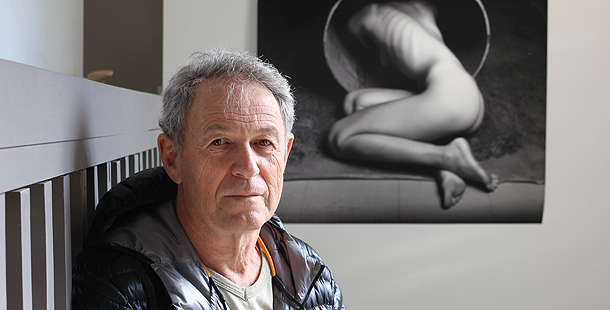
TOUCHING THE DREAM: World-renowned photographer Yuri Dojc, a long-time fan of Americana, did Nonnie Griffin a favour by shooting publicity stills for her current play, Marilyn — After. The experience also sated his own youthful fascination.
Photo shoot has Yuri Dojc reconnecting with youthful inspiration
When Yuri Dojc was asked to shoot publicity photos for Nonnie Griffin’s play Marilyn — After, he was intrigued.
The world-renowned photographer, who calls Lytton Park home when he’s not exhibiting his work in Berlin, Bratislava or Moscow, offered his services as a favour for the actress who’s performing her play Oct. 16-19 at the downtown theatre Buddies in Bad Times.
Deep down, shooting a woman portraying Marilyn Monroe sated his youthful fascination with Americana.
“You have to understand, in communist countries, America was the bad guy,” he shares, in the loft of his studio. “It was pumped into your head so much that you create the opposite in your brain.
“Instead of America being evil, you start to fantasize and create this fantasyland.”
Marilyn Monroe and Elvis Presley factored greatly into his dreamland, and when the Russians came knocking on Czechoslovakia’s front door during the Warsaw Pact Invasion of 1968, Dojc — born in Humenné, Slovakia — fled his homeland for England, with the hopes he would end up in the U.S.
He did not make it to America, however. In 1969 he arrived north of the border, where he attended photography school at Ryerson in Toronto.
“I realized there wasn’t going to be a support line in the U.S., so I came to Canada,” he recalls. “This is my early ages, where I had this preoccupation with this American Dream — and Marilyn and Elvis were a part of it.”

MARILYN 50 YEARS LATER: Nonnie Griffin portrays legendary screen star Marilyn Monroe.
So when Nonnie Griffin came for her shoot in early October, Dojc admits he was smitten, and referred to the octogenarian actress only as “Marilyn”.
With him for this shoot was his assistant Eun, who shared in his affinity for Americana.
“It was interesting to see two people, my assistant Eun and myself, looking at this American icon,” he says, his Slovak accent augmented by his joy. “It was sort of like being in a movie, the whole shoot.”
He takes a moment to steal away from the conversation to find a book of prints he did for an advertising campaign featuring toys. In every picture a statue of Marilyn Monroe is present.
He smiles.
“It was a very charming shoot,” he says. “It was so smooth and easy — no clashing of egos at all.”
His major work is nudes, and he’s been recognized by publications around the world as being in the same class as photographers Irving Penn, Man Ray, Bill Brandt, David Lachappelle and Robert Mapplethorpe.
La Reppublica‘s L’Espresso magazine named him one of the 17 best photographers in the world.
“That was a big honour, but nude photography in Canada is sort of frowned on,” Dojc admits, his eyes following some of his prints, the models vanilla, the shadows deep charcoal.
In a moment of vulnerability, or perhaps disdain, he remarks that the Canadian media fails to cover his some of his success stories, and relates an incident where he got rude comments from one art director.
“I was the first Canadian photographer featured on the cover of Communication Arts magazine. First ever. I’m walking on the street, and I see some art director, and guess what they told me? ‘How much did you pay them to put you on the cover?’. I was getting [positive] phone calls from the States — from total strangers. This is the difference: Americans wish you the total best. The only thing I get from Canada is this one guy.”

